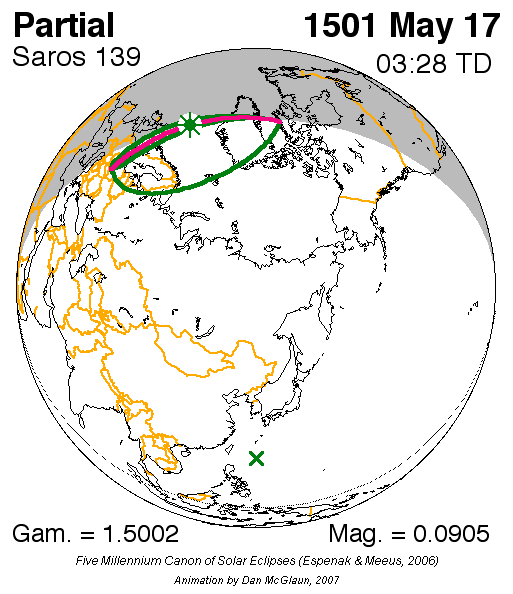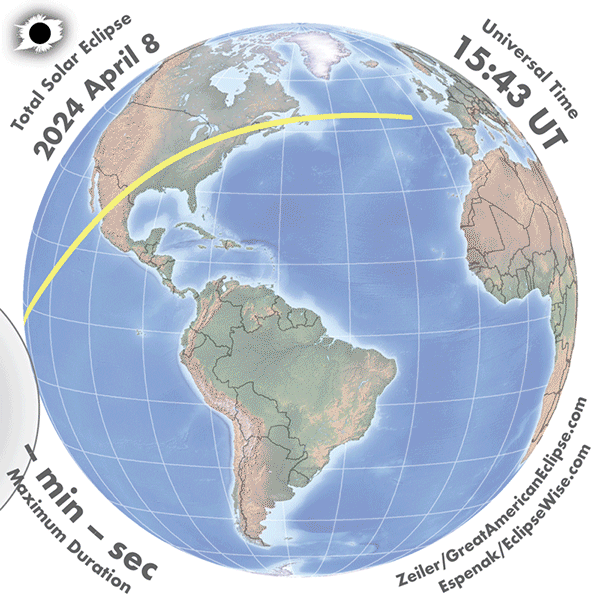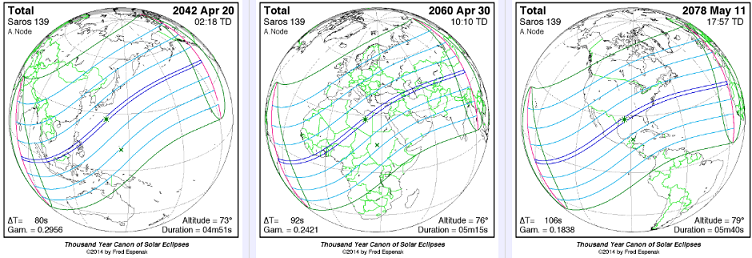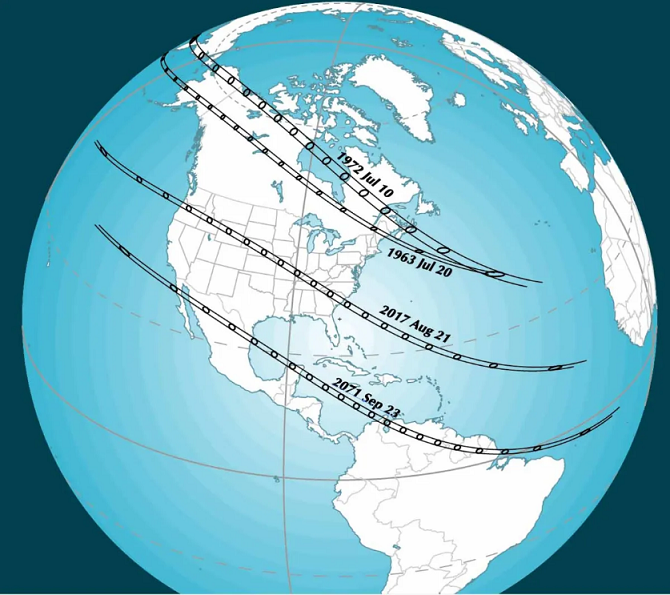The April 8 eclipse is part of Saros 139. What does that mean?

3-point summary
ChatGPT and Deborah Byrd created this 3-point summary of the article below:
- The April 8, 2024, eclipse is part of Saros 139, which began in the year 1501 and will conclude in the year 2763.
- Saros 139 includes a total of 71 related eclipses, with the April 8 eclipse being the 30th within this series.
- Related eclipses in a single S
aros Cycle trace similar paths across Earth’s globe. But the eclipse path – as traced by the moon’s shadow – falls at a different place on the globe for each eclipse.
Saros, the much-revered eclipse cycle
The next total solar eclipse is two months from today! Whether you intend to watch the partial, or the total eclipse, make your viewing plan now. It might seem as if eclipses happen randomly. But this coming eclipse – and every eclipse – is part of a pattern, or Saros Cycle. The April 8 eclipse belongs to Saros 139.
Saros 139 started in the year 1501. It’ll end in the year 2763. This particular saros contains 71 related eclipses. The April 8, 2024, eclipse is the 30th of these 71. What makes these eclipses related? They trace a similar pattern across the globe, albeit not in the exact same spot on the globe.
The saros is probably the most famous of the many, many eclipse cycles.
Chaldean (neo-Babylonian) astronomers left the earliest-discovered historical records of what is known today as the saros. Their records came from the last several centuries BC.

Saros period equals 18.03 years
For eclipse aficionados, the saros is useful because it organizes eclipses into families. Each saros series typically lasts 12 to 13 centuries and contains 70 or more eclipses.
Eclipses within a solar Saros series recur after 223 lunations, that is, 223 returns to new moon. And the time between new moons is 29.530589 days. So, the Saros period very nearly equals 6,585 1/3 days. That’s 18 years, plus 10, 11 or 12 (and a third) days, depending on the intervening number of leap years.
And so the immediate forerunner to the April 8, 2024 – its brother eclipse in the saros cycle – came to pass 18 years and 10 1/3 days before this coming April 8. That earlier eclipse happened on March 29, 2006. Looking ahead, the next eclipse belonging to Saros 139 – a future brother eclipse in this saros – will be in 18 years and 11 1/3 days. It’ll happen on April 20, 2042).
If you look at maps of all three eclipses (2006, 2024 and 2042), you’ll see what we said above is true. They all trace a similar path across the globe, albeit not in the exact same spot on the globe. See diagrams below.
Saros begins at one pole and ends at the other
Every saros series begins with a number of partial eclipses near one of Earth’s polar regions.
And so it was with Saros 139. Its first eclipse appeared in a far-northern part of the globe on May 17, 1501. Some 1,262 years later, the final eclipse of Saros 139 will take place along the coast of Antarctica on July 3, 2763.
Some Saros series begin at Earth’s North Pole, and others at Earth’s South Pole. Why?
The Earth’s orbit around the sun – and the moon’s orbit around Earth – aren’t on the same exact plane. The moon’s orbital plane is titled to that of Earth by about 5 degrees. The points where the moon’s orbit intersect the Earth’s orbit are called nodes. There’s an ascending node, where the moon is ascending through Earth’s orbital plane. And there’s a descending node, where the moon is passing from above the plane to below it.
The new moon must be at a node in order for a solar eclipse to take place. Otherwise, the moon can’t come between us and the sun.
And there lies the trick to where a saros series begins on Earth. Any saros series that starts at the moon’s ascending node starts near the North Pole and ends near the South Pole. Conversely, any saros series coinciding with the moon’s descending node starts in the south polar regions and ends north.
Saros 139 – containing the April 8, 2024, eclipse – started at an ascending node, and therefore at the North Pole.
Some eclipses in the series are partial
The early and late stages of any solar saros cycle present a rather poor alignment between the new moon and sun.
For this reason, the first seven eclipses and last nine solar eclipses of Saros 139 are only partial eclipses.
In short, no central solar eclipses – total, annular or hybrid – happen in the beginning and ending stages of any saros.
For Saros 139, the moon’s dark umbral shadow first landed on Earth and totally eclipsed the sun (though extremely briefly) on August 11, 1627. Since then, the central duration of these eclipses has been getting progressively longer.
April 8 eclipse: Saros 139’s longest solar eclipse to date
The eclipse on April 8, 2024, will present the longest total solar eclipse of the series to date (central duration: 4 minutes, 28 seconds). In comparison, the previous total solar eclipse on March 29, 2006, was somewhat shorter (central duration: four minutes, seven seconds). The next one on April 20, 2042, will be somewhat longer (central duration: four minutes, 51 seconds).


Longest totality yet to come
For the next 162 years, each following eclipse in this series will feature a longer total solar eclipse than its predecessor. Nine saros periods from now – July 16, 2186 – will showcase the longest total solar eclipse of Saros 139.
That’s not all, however! With a central duration of seven minutes and 29 seconds, it’ll present the longest total solar eclipse within a period of 10,000 years (4000 BCE to 6000 CE).
Convergence of factors for a long eclipse
Any total solar eclipse lasting seven minutes or longer is lengthy to the extreme. Indeed, a “perfect storm” of factors is necessary for a seven-minute total eclipse of the sun to take place:
The sun needs to be at or near apogee (farthest from Earth)
The moon needs to be at or near perigee (closest to Earth)
The greatest eclipse must happen in the tropics, rather close to the equator
Saros 139 can boast that five of its 43 total eclipses last over seven minutes. Although 40 solar saros series are in play at any one time, Saros 139 is head and shoulders above the rest for staging long totalities. In fact, this is the one and only solar saros series to provide seven-minute eclipses in the five-century period from 2001 to 2500:
2150 June 25 (seven minutes, 14 seconds)
2168 July 05 (seven minutes, 26 seconds)
2186 July 16 (seven minutes, 29 seconds)
2204 July 27 (seven minutes, 22 seconds)
2222 Aug 08 (seven minutes, 6 seconds)
Another total solar eclipse lasting seven minutes or better won’t happen again until June 14, 2504. After that – until 6000 CE – no solar saros will duplicate Saros 139’s feat of five seven-minute total solar eclipses.
The last time a solar saros produced five seven-minute total eclipses was 1,823 years previous to solar Saros 139. Saros 81 performed the trick from the years 327 to 399:
327 June 6 (seven minutes, 3 seconds)
345 June 16 (seven minutes, 17 seconds)
353 June 27 (seven minutes, 24 seconds)
381 July 08 (seven minutes, 22 seconds)
399 July 19 (seven minutes, 2 seconds)
The April 8 eclipse is the 30th of 71 members making up the grand succession of the Saros 139 solar eclipses.
Three times a charm: triple saros
Oftentimes, a given eclipse cycle is actually a combination of eclipse cycles. The saros eclipse cycle of 223 lunations stands as no exception. For example, the Tzolkinex Cycle with a period of 88 lunations and Tritos Cycle with a period of 135 lunations nicely add up to one saros period of 223 lunations.
Moreover, three saros periods add up to one exeligmos period of 669 lunations. The exeligmos has the advantage of sporting an integral number of days: 19,756 days (54 years and 33 days).
The longest solar eclipse of Saros 139 will come exactly three exeligmos periods after the April 8, 2024, total solar eclipse. That’s in 162 years and 99 days, on July 16, 2186.

Bottom line: Enjoy the April 8 eclipse as you witness the 30th of 71 member eclipses in the illustrious procession known as Saros 139.











